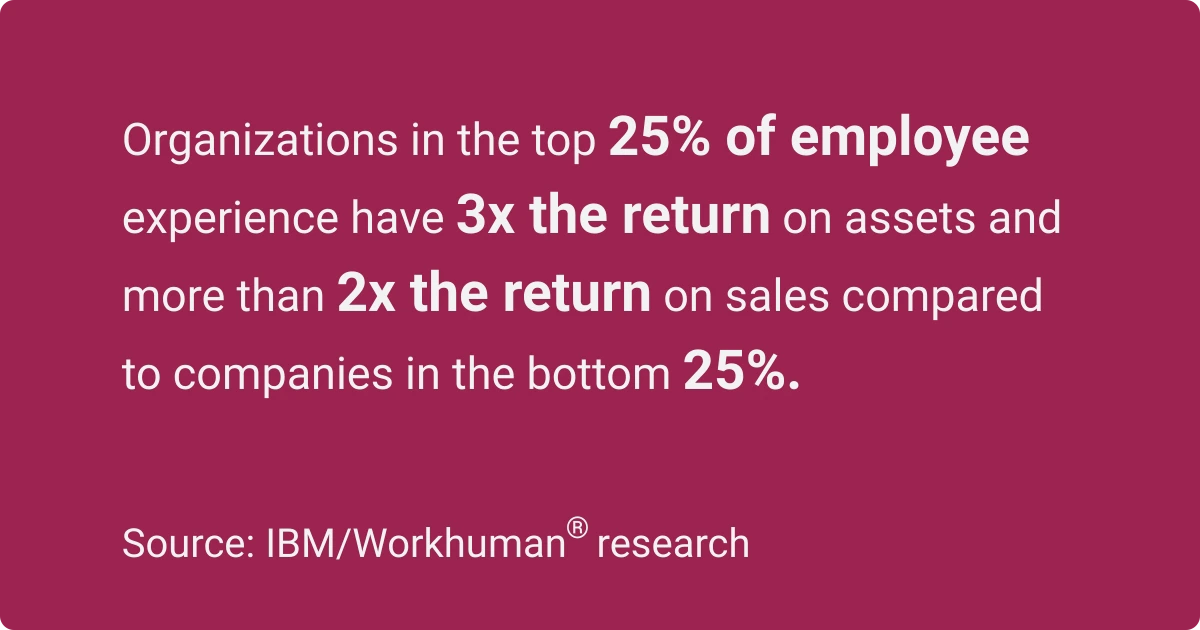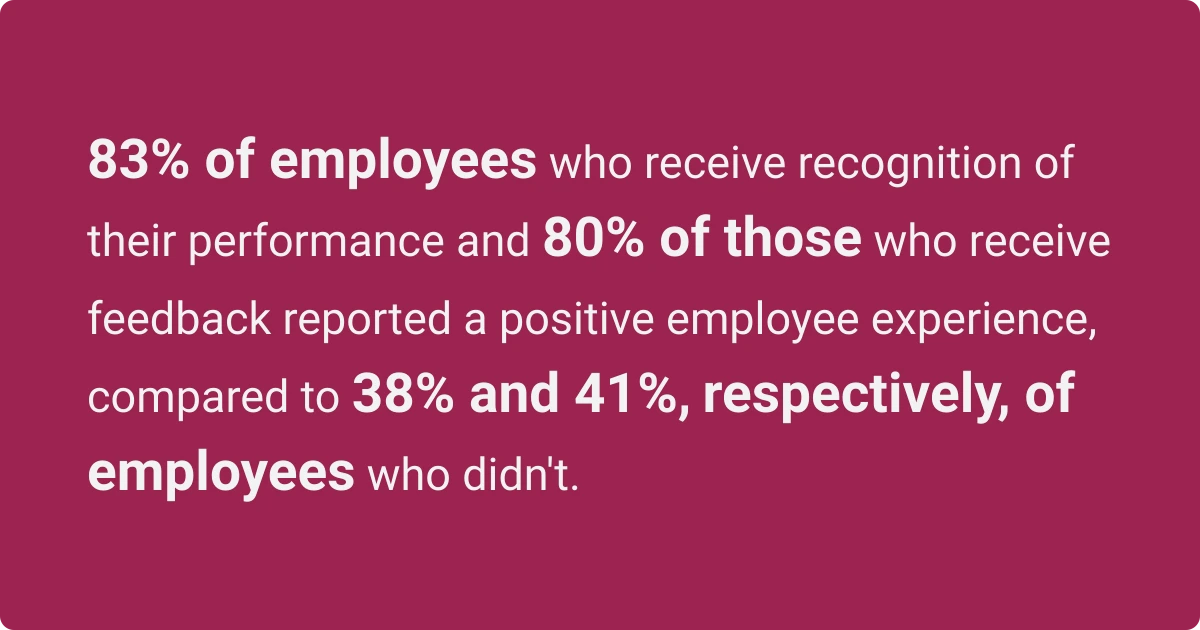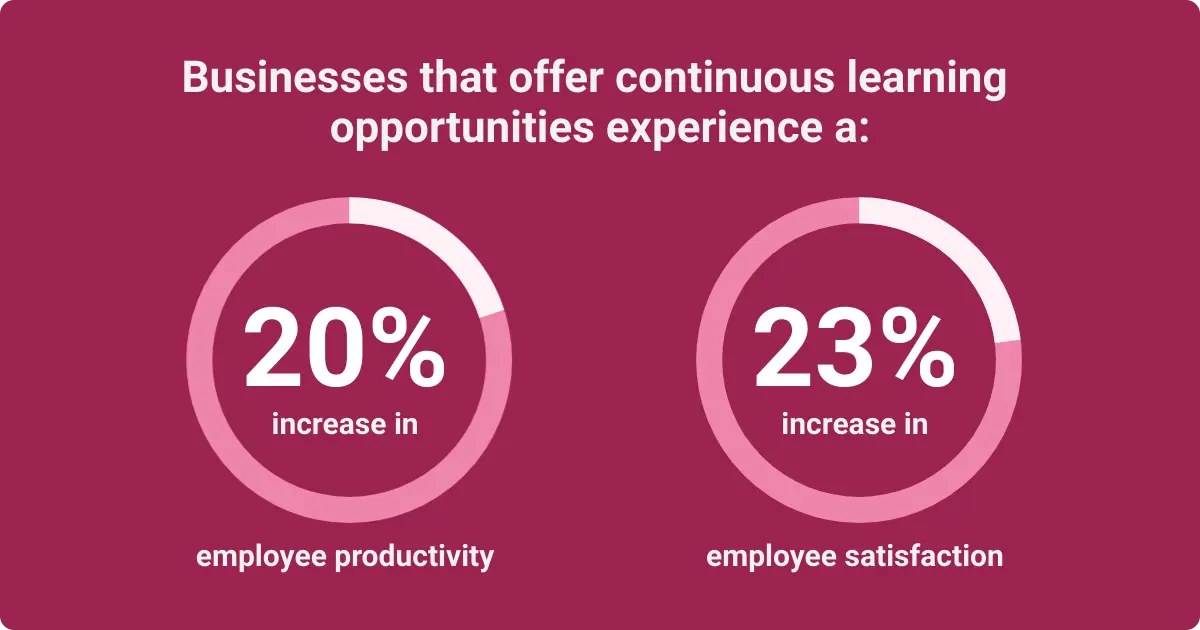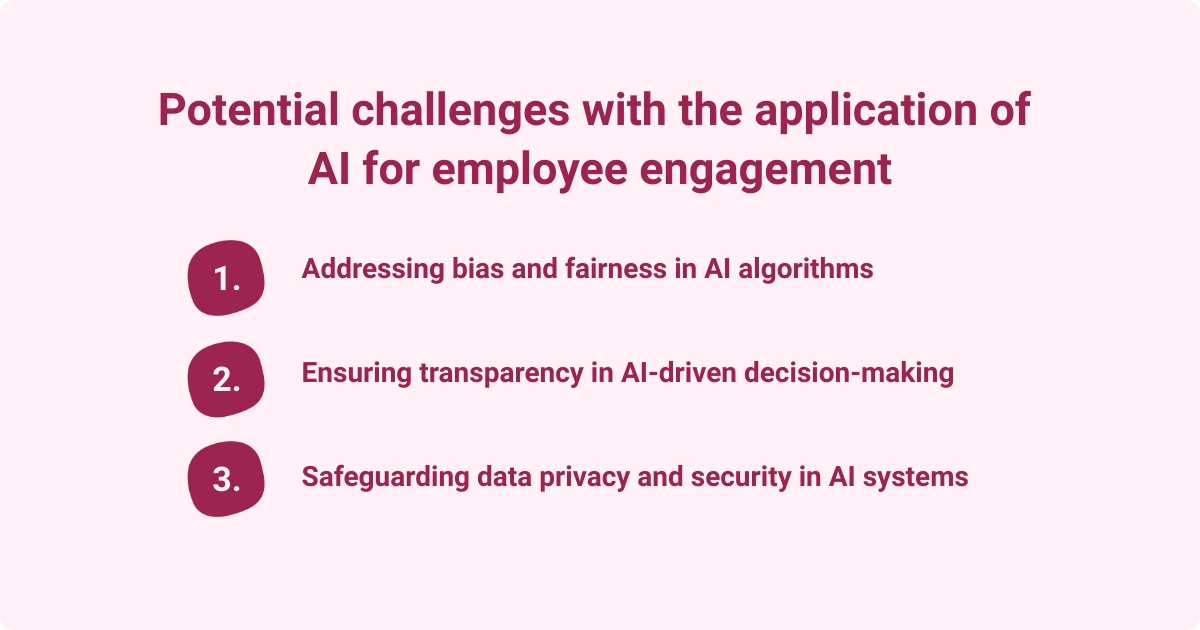How to Use AI in Employee Engagement to Transform the Workplace Experience
Table of contents
- The role of AI in enhancing employee engagement
- Advantages of using AI employee engagement tools
- How are AI technologies reshaping employee engagement strategies?
- How companies can get started with artificial intelligence to boost employee engagement
- Potential challenges with the application of AI for employee engagement
- Examples of how to leverage AI in your engagement strategies
- Conclusion

The world of work has changed drastically in recent years - and, with it, employee sentiment about the workplace. Gallup research explored in a co-authored report with Workhuman shows only 33% of employees in the U.S. and 23% of employees globally are engaged at work.
You read that right.
To make matters worse, Gallup research shows more than half of the world's employees are signaling their discontent with their current workplace by watching for or actively seeking a new job.
Boosting employee engagement is crucial to improving employee retention, morale, and productivity. It can also have a significant impact on your bottom line. According to Gallup, not engaged or actively disengaged workers cost $1.9 trillion in productivity annually.
As disengagement at work rises, many businesses are turning to artificial intelligence (AI) tools to increase employee motivation and satisfaction. Discover the benefits of AI in employee engagement and practical tips for using this cutting-edge technology to support your workforce.
The role of AI in enhancing employee engagement
For many businesses, employee engagement – or the lack of it – has been a top concern since the COVID-19 pandemic. This term refers to more than just feeling happy at work. According to Dr. Meisha-ann Martin, VP of People Research at Workhuman, “We’re talking about people personally connecting to their work and being enthusiastic and energetic about it.”
Artificial intelligence is one of the most powerful tools in your toolkit for increasing employee morale and improving the work environment. This technology allows you to gather feedback from employees and develop strategies to improve employee engagement. Plus, AI can support professional development, helping employees feel more motivated and invested in their careers.
Businesses also use AI technology to automate repetitive tasks that may bore or frustrate employees. Instead of spending endless hours on data entry or managing emails, workers can focus on more creative and engaging tasks. For example, a marketing team could use the time saved through automation to launch a bold social media campaign or explore new content creation tools.
Advantages of using AI employee engagement tools
At first, using AI in the workplace to enhance employee engagement may seem counterintuitive. You may worry that AI-powered tools could make your team feel more disconnected, but that’s not the case. Here are five benefits of using AI tools to improve employee satisfaction and wellbeing.
Tailoring employee experiences with AI
Your employees have diverse goals, preferences, and work styles. AI helps you understand and address these unique needs so you can offer personalized experiences for every team member.
For example, an advanced AI scheduling tool can analyze historical customer traffic, employee availability, skills, and other information. Based on this data, the system can create flexible schedules that account for each worker’s needs and strengths. This process can boost employee satisfaction by improving work-life balance and optimizing staffing levels.
AI also helps employees expand their knowledge and upskill. You can use this technology to assess every team member’s proficiency and identify skill gaps. With these data-driven insights, AI can develop personalized learning paths and offer career advancement recommendations. For instance, some employees might benefit from leadership training, while others need to improve their data analytics skills.

Personalizing the employee experience with AI can lead to significant financial rewards. A Workhuman study found that organizations in the top 25% for employee experience have three times the return on assets and double the sales compared to businesses in the bottom 25%.
Findings from the study reveal organizations that deliver a positive employee experience through human workplace practices like recognition, empowerment, and feedback, see a significant impact on return on assets and return on sales.
Improving communication and collaboration with AI
These days, it’s rare for teams to work in neighboring cubicles. Employees must often collaborate with remote colleagues, hybrid workers, and even people in different countries. These distant partnerships can lead to frustrating miscommunications and poor coordination, especially across time zones.
AI systems can boost employee engagement by streamlining communication across teams. Some businesses use AI chatbots to help employees quickly retrieve information or answer questions. That way, they don’t have to wait for their colleagues to check their emails.
Additionally, AI-powered speech-to-text tools like Otter.ai and Voiceitt make it easier for employees with disabilities to participate in discussions.
Many team collaboration platforms also feature AI tools. For instance, Slack AIOpens in a new tab can recap conversations and summarize files, improving transparency and coordination. This technology makes it easier for teams to communicate and exchange feedback in real-time, leading to more satisfying partnerships.
Leveraging real-time feedback and performance tracking
Continuous performance management is key to high employee engagement. Research from Workhuman® shows that workers who receive regular feedback feel more connected to their colleagues, have more trust in their managers, and perform better.

AI tools can play a crucial role in tracking and improving employee performance. Workhuman’s Conversations® tool allows managers and employees to schedule frequent, high-quality check-ins. Workers can request feedback whenever they need guidance and support. The platform’s assessment features also make it easy to identify strengths and areas for development.
Of course, feedback is a two-way street. Sentiment analysis tools like Workhound use AI to gather and analyze anonymous, real-time feedback from employees. This data enables organizations to monitor job satisfaction and take steps to boost engagement and performance.
For instance, AI data analytics might reveal that staffing shortages are affecting morale, prompting you to hire more employees to reduce stress.
AI solutions for continuous learning and development
According to a Gallup study on why employee upskilling is vital in a rapidly evolving job marketOpens in a new tab, only 47% of employees believe they have the necessary skills to excel in their current roles. Artificial intelligence platforms can support continuous learning and help workers and employees achieve their career goals.
Many AI systems allow organizations to personalize workforce training. For example, Workhuman iQ®’s talent intelligence feature uses recognition data and natural language processing to map your employees’ skills and reveal gaps. You can also use the AI Assistant to match employees with mentors who can help them grow. These insights—what we call Human Intelligence™—enable you to offer tailored courses and training materials based on each employee’s skill gaps.
Workhuman iQ can transform your understanding of the employee experience with AI-powered social analytics to unlock data-driven strategy. It's the kind of intel you’ve always wanted, delivered in a way that anyone can use.
Plus, AI tools like SC TrainingOpens in a new tab automatically deliver learning materials and assessments straight to your team’s devices. This convenient feature guarantees that employees always have access to the latest development resources.

Continuous learning is more than just a way to build your team’s skills. It also increases employee productivity and satisfaction, leading to higher long-term engagement.
Using predictive analytics to increase employee retention
Turnover often feels unpreventable, but that’s not always the case. In fact, a 2024 Gallup surveyOpens in a new tab revealed that 42% of employees who voluntarily left their jobs would have stayed if their manager had intervened.
Obviously, you can’t read employees' minds to know if they’re considering leaving. However, AI tools can provide deeper insights into employee behavior and help identify potential flight risks. Workhuman iQ draws from over 100 million data points to assess the likelihood that employees will leave.
Predictive analytics empowers you to create strategies to boost retention. If you discover that your staff feels undervalued, you can use recognition software like Social Recognition to celebrate their achievements.
If isolation is a factor for remote workers, you could help your team bond with fun activities for employee engagement. This proactive approach will help improve engagement and retention.
How are AI technologies reshaping employee engagement strategies?
Using artificial intelligence can feel daunting, but don’t worry. You don’t need to build custom software from scratch or have advanced tech skills to use AI and machine learning effectively. There are a variety of existing tools for boosting morale and motivating your team.
AI chatbots and virtual assistants
Many organizations use AI chatbots to provide 24/7 support and collect employee feedback. These tools typically rely on natural language processing (NLP) to understand human input and generate conversational responses. For example, the Workativ chatbot answers questions about company policies and resolves IT issues, while Workato's Benefits Bot helps employees submit claims.
Virtual assistants also enhance engagement by empowering employees to handle tasks independently. Like chatbots, this software uses NLP to interpret and perform complex requests, such as scheduling appointments and taking meeting notes. Popular virtual assistants include Microsoft Copilot and Google Gemini.
Sentiment analysis and feedback tools
Sometimes, it’s easy to detect employee dissatisfaction. You might notice your staff rolling their eyes during meetings or grumbling about new policies. Often, though, discontent and disengagement are more insidious and difficult to recognize.
AI can analyze employee sentiment and identify trends. For example, with Workhuman's Inclusion Advisor, AI can analyze data from 70-plus million moments of recognition to pick up on subtleties in recognition messages, educating employees about bias in real time. Meanwhile, platforms like Hootsuite and Sprout Social provide insights into how employees discuss your organization on social media.
This technology helps you identify potential concerns or dissatisfaction early, allowing you to take timely action. Say your organization asks employees to take on new responsibilities. If sentiment analysis reveals that staff feel overwhelmed, you could address the issue by clarifying expectations or bringing on additional help.
This strategy shows employees you value their feedback and well-being, which can increase engagement and satisfaction.
Predictive analytics for engagement
No one can see the future, but predictive analytics tools come as close to a crystal ball as a human resources (HR) department can get. Platforms like Workhuman and Workday use AI to collect historical data related to employee engagement, such as:
- Employee survey results
- Engagement levels
- Number of recognitions
- Participation in workplace training activities
- Performance trends
- Retention rates
- Turnover rates
These AI tools then use machine learning algorithms to analyze the data and extrapolate future trends. For example, a sudden decrease in employee recognition could cause employee engagement to plummet. By contrast, a steady increase in workshop participation might indicate that employees are becoming more invested in your organization.
AI-powered learning and development platforms
We’ve all been there – sitting through a boring or irrelevant training session, counting down the minutes until it's over. AI learning platforms can change this by creating personalized content tailored to your team’s interests and performance.
Adaptive learning software like SC Training and Whatfix adjusts content and delivery methods for each user. Employees struggling to learn a new skill can receive extra guidance, while those who’ve already mastered a topic can skip repetitive content. These tools reduce frustration and boost engagement by allowing users to follow personalized pathways.
Gamification tools, such as Centrical and Docebo, can also significantly enhance motivation and excitement. Employees can compete for the top spot on their department’s leaderboard or sharpen their skills through challenging training exercises. These tools transform training from a tedious chore to a fun, rewarding experience.
How companies can get started with artificial intelligence to boost employee engagement
You may feel tempted to experiment with every trendy AI tool but resist the urge to go on a shopping spree. Taking a slow, strategic approach will help you get the most out of this technology without overwhelming your employees. Follow these steps to set yourself up for success.
1. Assess your current engagement methods
Begin by evaluating your engagement program’s strengths and areas for improvement. Maybe your organization has an awesome employee onboarding program but offers limited professional development opportunities for senior employees.
Or perhaps your team loves your flexible work arrangements but struggles to collaborate. These areas offer valuable opportunities to boost employee performance and engage your team more effectively.
2. Choose the right AI tools
Once you’ve identified your needs, research platforms that offer relevant features. For example, if you want to monitor employee satisfaction, look for sentiment analysis tools. If you aim to reduce burnout, consider an AI-powered scheduling system.
Ask vendors for live demonstrations so you can see each tool in action. Case studies and reviews also help you gauge the software’s useability and quality.
3. Launch a pilot program
Start small by creating a pilot program for your chosen AI tool. Select one department or team to trial the platform for a few months and provide feedback. This approach lets you learn how to use the system and troubleshoot any issues before a company-wide rollout.
4. Measure the impact and refine your strategies
Don’t rely on your intuition to tell you if your new AI tool is working. Gather key metrics such as employee satisfaction scores throughout the process to measure its effectiveness. This data will enable you to adjust your approach as needed.
5. Address employee concerns
Even the most adaptable team members may feel anxious or resistant to new technology. HR professionals and leadership can ease the transition by emphasizing the benefits of AI tools for workforce engagement and offering in-depth training. Even a simple meeting to explain how an AI platform handles employee data can go a long way toward increasing employee trust and buy-in.
Potential challenges with the application of AI for employee engagement

While AI tools offer many benefits, they pose several ethical and security issues. Here are a few challenges you may encounter when you incorporate this technology into your engagement efforts.
1. Addressing bias and fairness in AI algorithms
People often assume that technology is innately neutral and impartial, but that’s not true. AI systems can inadvertently introduce biases against specific groups and reinforce inequalities.
In 2024, for example, Workday faced a class-action lawsuitOpens in a new tab after a Black job applicant alleged that its AI hiring software screened him out based on his race. The same year, CVSOpens in a new tab settled a lawsuit after the company used an AI tool to analyze job candidates’ facial expressions during interviews and assign them an “employability score.”
The American Civil Liberties Union alleged that the technology discriminated against candidates with disabilities and people of color.
These cases highlight the dangers of biased decision-making in AI-driven HR systems. Organizations must actively work to mitigate bias and create fair algorithms. To do so, they should use tools trained on inclusive datasets and conduct regular bias testing.
Some AI platforms also have built-in inclusivity features. Workhuman's Inclusion Advisor, for example, actively promotes equity by flagging biases in recognition messages, such as gendered language and backhanded compliments. Managers can dig deeper and analyze unconscious bias trends using Workhuman iQ dashboards, then tailor their actions to better support all employees equally.
2. Ensuring transparency in AI-driven decision-making
AI systems can collect vast amounts of employee data, from attendance records to engagement levels. Understandably, your team may have concerns about how this data is used and how it will affect their work experience.
Transparency is key to establishing trust with employees. Leaders should clearly explain how AI tools work and how they’ll use this technology for measuring engagement. Organizations should also be candid about how AI platforms will affect performance evaluation and promotions.
For example, you might anonymize certain information to protect employee privacy, while other data may factor into promotion decisions.
This clarity will help your company avoid fears of discrimination. It can also increase employees’ willingness to engage with AI technology.
3. Safeguarding data privacy and security in AI systems
Like any computer system, AI engagement tools are vulnerable to cyber threats and data leaks. Organizations must protect employee data by implementing robust security protocols, such as firewalls and multi-factor authentication. Ethical data collection practices are essential for safeguarding privacy, such as anonymizing data and gathering only necessary information.
Additionally, businesses must comply with relevant laws, such as the General Data Protection Regulation and the California Privacy Rights ActOpens in a new tab . Following these regulations strengthens workforce trust and maintains employee privacy.
Examples of how to leverage AI in your engagement strategies
Artificial intelligence may still seem like a sci-fi concept, but many companies have already begun using this technology in their engagement initiatives.
For example, Microsoft has developed an internal employee engagement platform called AskHR. This tool uses AI to answer over 4,500 inquiries daily about everything from benefits to policy. The platform also supports new hire onboarding and helps employees transfer to new roles. This tool improved Microsoft’s net satisfaction rating by almost 10%.
Meanwhile, the home care franchise GriswoldOpens in a new tab uses Ava AI to address critical staffing shortages in the industry. The software uses predictive analytics to forecast caregiver turnover and recommends gamification strategies to improve employee retention and recruitment. According to Griswold, this technology reduced the company’s turnover rate by 13% in just seven months.
Conclusion
Creating a highly engaged work culture doesn’t happen by accident. If you want your employees to feel invested in your organization’s success, you must continually demonstrate your commitment to their well-being and offer opportunities for growth.
Using AI in employee engagement helps foster an open and positive culture. This technology enables you to support professional development, improve collaboration, and provide personalized experiences. These efforts can drastically increase motivation by showing your employees you truly value them.
Get started today by researching AI engagement tools. With a little effort and patience, you’ll be well on your way to developing a more engaged, passionate, and productive workforce.